All Sorts of Tours!
It’s a day of tours, from a war tour to a walking tour, and a food tour!
But first breakfast!
I normally skip over breakfast, but this one seems to have the oddest combination of foods. There was cereal, egg, sausage as well as garlic bread, focaccia, tins of fish, baklava, a fresh press orange machine and 4 different coffee machines; Iain was in his element.
After breakfast, we went back upstairs to get ready for our first tour of the day. We were just getting organised when the phone rang and reception said our guide was there, 20 minutes early. Iain went down ahead of me, but the guide was really apologetic and thankfully no-one else was waiting for us.
Amir was our guide (a veteran of the war) and ordered us into the front seats beside him, it was a minibus so we were unsure if anyone else was coming along or not. Apparently we had a few more people to pick up, but he started telling us stories and point out things as we went anyway. Apart from war stories, he also told us that he paid a man 50 Euros for his driving licence, and the man told him he would eventually be a good driver; given that he missed every gear, I’m not convinced he has improved but then that might be because the van was older than me and there were numerous lights on the dashboard that shouldn’t be illuminated!
But first breakfast!
I normally skip over breakfast, but this one seems to have the oddest combination of foods. There was cereal, egg, sausage as well as garlic bread, focaccia, tins of fish, baklava, a fresh press orange machine and 4 different coffee machines; Iain was in his element.
After breakfast, we went back upstairs to get ready for our first tour of the day. We were just getting organised when the phone rang and reception said our guide was there, 20 minutes early. Iain went down ahead of me, but the guide was really apologetic and thankfully no-one else was waiting for us.
Amir was our guide (a veteran of the war) and ordered us into the front seats beside him, it was a minibus so we were unsure if anyone else was coming along or not. Apparently we had a few more people to pick up, but he started telling us stories and point out things as we went anyway. Apart from war stories, he also told us that he paid a man 50 Euros for his driving licence, and the man told him he would eventually be a good driver; given that he missed every gear, I’m not convinced he has improved but then that might be because the van was older than me and there were numerous lights on the dashboard that shouldn’t be illuminated!
Before we start, I feel I need to explain a little about Bosnia & Herzegovina. There is obviously peace now, but there are political divisions, created by the Dayton Agreement, which divides the country into two federal entities: the Federation of Bosnia and Herzogovina and the Republika Srpska and one condominium named the Brćko District. The war I am about to talk about was between the two Federal districts, with Republika Srpska supported by Serbia and Slobodan Milošević. The belief was that all Serbs should be part of Serbia, a belief that is still held today and is evident to see in Bosnia with different flags and Cyrillic in the Bosnian Serb areas.
But for now, back to the tour!
But for now, back to the tour!
As we drove from our hotel street, he mentioned that we would have been unsafe here during the war as there was a sniper in the hills above Sarajevo and he would have fired on us. The sniper wouldn’t shoot to kill though, he would shoot to wound which would drag more people out into the open and he would be able to kill even more. What a thought!
We eventually picked up everyone, and he started with a Veterans tour of Sarajevo.Amir joined the Bosnian Army at age sixteen, he joined to fight against the Republic of Serbia in the war that started in 1992. His brother was also in the army and 5 years older than him; unfortunately, his brother was killed in 1992 with a dumdum (expanding) bullet through the heart. He explained about hearing that his brother was shot and he was sent to the hospital to find him; he was directed to a building which he then realised was the morgue as there was no electricity and the bodies were decomposing. When he found his brother, he had his eyes open, so he closed them then had to go home to his mother to tell her; it was a horrible story. Even his mother was shot at by a sniper, nobody was safe, even old people and children.
Amir was also injured twice; first with shrapnel the size of a piece of rice into his brain and the second time much worse that he could not walk. He assured us that the shrapnel had been checked recently, and he was ok. Now before I go on, Amir seemed a bit nuts (in a good way!), but I’m attributing that to the shrapnel!
As we drove to our first real stop, we passed buildings which showed bullet holes and mortar shell holes, its hard to believe this war was during our lifetime. Basically, the Serbian Army surrounded the city from the hills and they had a perfect view of every street. The Serbian Army had artillery, so the Bosnian Army had to get as close as possible to them so they couldn’t use it; they were literally in buildings next door to one another.
We also passed the Hotel Holiday Inn where journalists stayed during the siege; he mentioned the reporting of Christiane Amanpour and how her emotive journalism helped to show the sufferings of the Bosnians. What was really interesting was he went to school opposite the hotel when he was a young boy, and at the time Radovan Karadžić, an ally of Slobodan Milošević and then Prsident of Republika Srpska, stayed here and he wishes he could have killed him as the war would have been made more difficult. Karadžić is now serving life for War Crimes in a prison in the UK!
We arrived at the “Tunnel of hope” which was built in a 4 month period during the siege; it was built as the people in Sarajevo were starving and needed supplies, and as people attempted to run across the runway from the centre of Sarajevo to Bosnian-held territory on the other side of the airport, they were being killed by snipers. The tunnel was 800 metres in length, 1 metre wide and 1.6 metres in height. The UN occupied the airport, and it was a no-fly zone across the city apart from UN and NATO planes. Amir told us the building of the tunnel was top secret, everyone in Sarajevo was discussing it over coffee, and even the Serbs knew of it. In fact, the Serbian Army were so unhappy that the UN allowed it as they are supposed to be impartial, but the UNs response was that they are only responsible for things above ground. Amir wasn’t actually a fan of the UN, and instead called them United Nothing, but this tunnel was the saving grace for Sarajevo, so it was a good response from the UN.
We watched some real footage from the war, and how the tunnel was used. The museum also provided more information on the War and there were weapons and other pieces of clothing that were preserved. The siege lasted 1425 days, 11541 people were killed, 1601 of them children. Amir also pointed out the Sarajevo Roses on the ground, they are actually places where mortar shells have landed and more than 3 people were killed; there was a rose at the entrance to the Tunnel museum. There is only 100 metres of tunnels left, which we got to walk down; obviously there is now electricity and the tunnel has been made safe for tourists, but you get the idea.
Our next stop was the petrol station before we ran out of fuel! One of the red lights on the minibus went out!
After topping up, we drove to Trebević, a mountain overlooking the city where the Serbian Army were stationed. This place was originally famous for the 1984 Olympic Games, and this is where the luge and bobsleigh were. We parked the van, then walked up to the viewpoint. There is also a cable car, but that would be too easy. The view of Sarajevo was fantastic, its such a beautiful country. We got to walk down the bobsleigh which as some spectacular graffiti, its crazy to think just 8 years before people were celebrating holding the Winter Olympics here.
We got back in the van and stopped off at a bombed out restaurant; it was actually bombed by NATO and was the Military HQ of the Republic of Serbia Army. The restaurant had perfect views across the city, it was no wonder it was perfect for planning artillery strikes on the city.
Our last stop was the Jewish Cemetery, with more than 3850 graves. Some of the gravestones had holes and the memorial to all the Jews who died during WW2 had a massive mortal shell hole in the back of it. Some of the gravestones were even tilting as they had been used for sniper rifles by the Serbian Army, the recoil causing the stones to move.
The whole tour was quite sobering, and it was a privilege to hear first-hand what he and his family went through. His mum actually just passed away 84 days ago, he was quite emotional as he never got to see her due to Covid restrictions in the hospital here. As we were finishing up, I also asked him if he hated Serbians, he said he did at first but he realised it would destroy him thinking like that; he did say that he didn’t trust them however!
Amir dropped us back in the centre, where we decided we needed a beer or two. Most of the little bars in the old town are down side streets, so we found a place in the shade. We had a couple of drinks which seemed to take up the time we had between tours, then headed to City Hall to meet Emina.
The next tour was a walking tour and a food tour in one; we started at City Hall, a beautiful building which was clearly built by the Austro-Hungarian Empire. It was destroyed during the war and all the books inside it burned. Our next stop was in the old part of Sarajevo from the 16th Century, we went into a metal workers shop to see how he made various bits and pieces; the most interesting was the mortar shells which he had made into beautiful vases and bullets into pens. The guy was great fun, but I’m not sure why he had a baseball bat beside him!
The next stop was our first food stop; we were going to have some traditional Bosnian pie. It’s like a pastry filled with either meat or cheese; we decided to try both and share. Now the weird thing is you get a pot of yoghurt to go with it, we did as the guide did and poured it over, it was delicious and quite filling.
It was time for a wander again, she took us to the fountain, which was built in Ottoman times. They have the same theory that if you drink water from here, you will stay in the city! Unfortunately, the square is full of pigeons so we made a quick exit as I explained my irrational fear of birds. It was roasting but it was time for Bosnian coffee. Emina showed us how to drink it and explained that she usually has 4 a day, two in the morning then two late afternoon! I’m not convinced I would be able to sleep after that.
We then walked past the largest mosque in the city, followed by their “Big Ben,” a learning centre and library, Synagogue, Catholic Church and Orthodox Church. Up to this point, we had only been in Old Sarajevo, but we crossed over into New or Modern Sarajevo; its quite clear from the difference in architecture but there is also a sign on the pavement which signifies this. As you can tell, Sarajevo is a very diverse place, although it is 60% Muslim.
The next important stop was where Archduke Franz Ferdinand was killed, the event which started WW1. I’m not sure if you can see it, but he plaque on the pavement shows exactly where Gavrilo Princip was standing when he shot him.
Emina is actually Muslim, although she chooses not to wear a headscarf and dyes her hair blonde. I’m not sure how, but she has keys to the oldest mosque in the city, so took us in to see it. Obviously, I wasn’t expecting it, but she gave me a long skirt and a headscarf. The mosque was small but quiet and really quite peaceful. The cats were also enjoying the peacefulness!
Neither of us were hungry, but it was time for our next food stop. It was Ćevapi Pita which is basically lots of mini koftas in a pitta bread. We managed all the koftas, but there was no chance we were finishing the pitta too; we did our best though!
That was it for the tour, we had seen lots and eaten way more than we needed. We said goodbye to Emina and headed straight to a bar for a coke and a beer. All the meat here is super tasty, but it is so salty, we were dying of thirst. I decided to try a lemonade, never again, it really was natural lemon juice with very little sweetener and very sour. We stayed here for one drink, then headed back towards the hotel, stopping at Teraza, a bar just beside Thriller, the bar we were at last night. I’m completely addicted to their version of Aperol Spritz, it seems to be less fizzy, but its delicious!
Amir was also injured twice; first with shrapnel the size of a piece of rice into his brain and the second time much worse that he could not walk. He assured us that the shrapnel had been checked recently, and he was ok. Now before I go on, Amir seemed a bit nuts (in a good way!), but I’m attributing that to the shrapnel!
As we drove to our first real stop, we passed buildings which showed bullet holes and mortar shell holes, its hard to believe this war was during our lifetime. Basically, the Serbian Army surrounded the city from the hills and they had a perfect view of every street. The Serbian Army had artillery, so the Bosnian Army had to get as close as possible to them so they couldn’t use it; they were literally in buildings next door to one another.
We arrived at the “Tunnel of hope” which was built in a 4 month period during the siege; it was built as the people in Sarajevo were starving and needed supplies, and as people attempted to run across the runway from the centre of Sarajevo to Bosnian-held territory on the other side of the airport, they were being killed by snipers. The tunnel was 800 metres in length, 1 metre wide and 1.6 metres in height. The UN occupied the airport, and it was a no-fly zone across the city apart from UN and NATO planes. Amir told us the building of the tunnel was top secret, everyone in Sarajevo was discussing it over coffee, and even the Serbs knew of it. In fact, the Serbian Army were so unhappy that the UN allowed it as they are supposed to be impartial, but the UNs response was that they are only responsible for things above ground. Amir wasn’t actually a fan of the UN, and instead called them United Nothing, but this tunnel was the saving grace for Sarajevo, so it was a good response from the UN.
 |
| Some of the people who built the tunnel |
 |
| The red line shows the tunnel |
 |
| The family of the house where the tunnel came up - they wanted a museum to be made to remember it |
Celebs who visited the tunnel (Amir said - see, we are nice people, we left Kevin Spacey on the board!)
We watched some real footage from the war, and how the tunnel was used. The museum also provided more information on the War and there were weapons and other pieces of clothing that were preserved. The siege lasted 1425 days, 11541 people were killed, 1601 of them children. Amir also pointed out the Sarajevo Roses on the ground, they are actually places where mortar shells have landed and more than 3 people were killed; there was a rose at the entrance to the Tunnel museum. There is only 100 metres of tunnels left, which we got to walk down; obviously there is now electricity and the tunnel has been made safe for tourists, but you get the idea.
Our next stop was the petrol station before we ran out of fuel! One of the red lights on the minibus went out!
After topping up, we drove to Trebević, a mountain overlooking the city where the Serbian Army were stationed. This place was originally famous for the 1984 Olympic Games, and this is where the luge and bobsleigh were. We parked the van, then walked up to the viewpoint. There is also a cable car, but that would be too easy. The view of Sarajevo was fantastic, its such a beautiful country. We got to walk down the bobsleigh which as some spectacular graffiti, its crazy to think just 8 years before people were celebrating holding the Winter Olympics here.
Amir dropped us back in the centre, where we decided we needed a beer or two. Most of the little bars in the old town are down side streets, so we found a place in the shade. We had a couple of drinks which seemed to take up the time we had between tours, then headed to City Hall to meet Emina.
The next important stop was where Archduke Franz Ferdinand was killed, the event which started WW1. I’m not sure if you can see it, but he plaque on the pavement shows exactly where Gavrilo Princip was standing when he shot him.
Emina is actually Muslim, although she chooses not to wear a headscarf and dyes her hair blonde. I’m not sure how, but she has keys to the oldest mosque in the city, so took us in to see it. Obviously, I wasn’t expecting it, but she gave me a long skirt and a headscarf. The mosque was small but quiet and really quite peaceful. The cats were also enjoying the peacefulness!
After three drinks each, we thought we better get back to the hotel as we have an early start in morning and a long drive to Mostar.



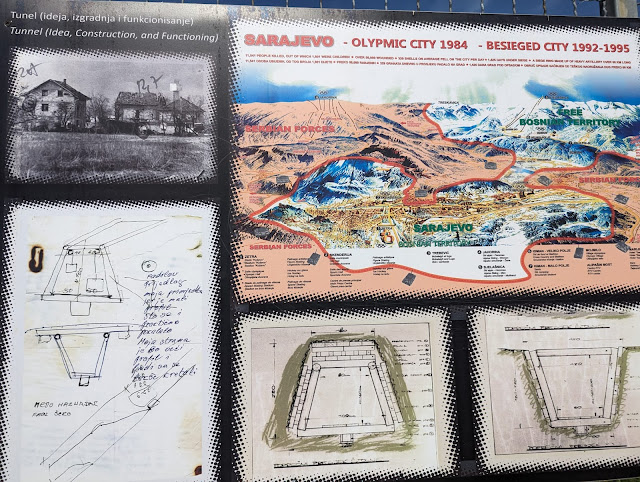




















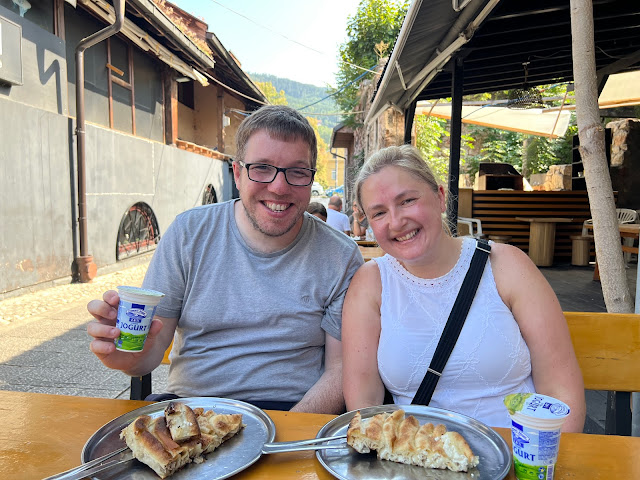

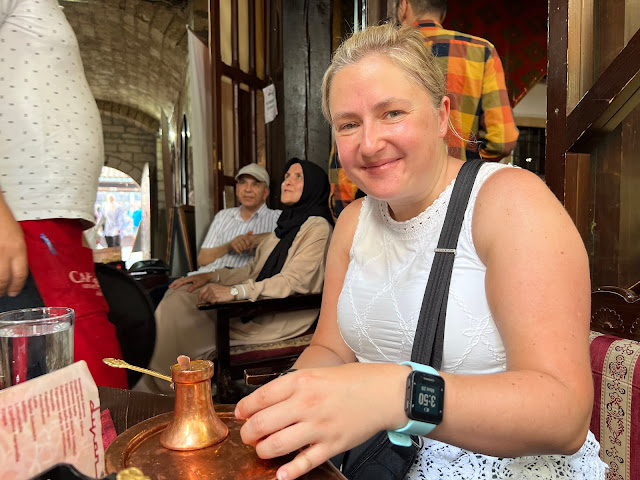
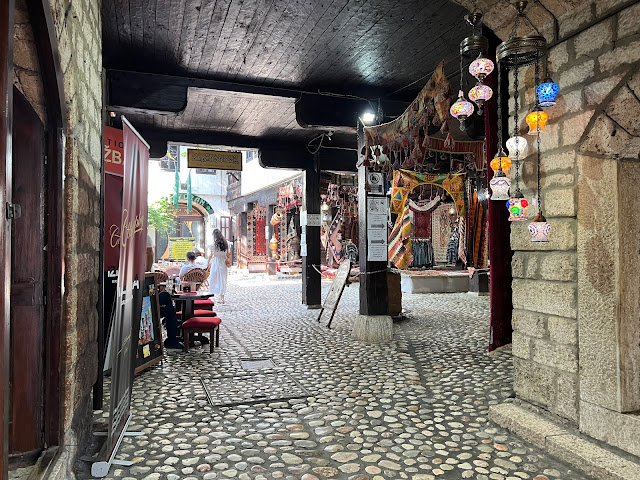










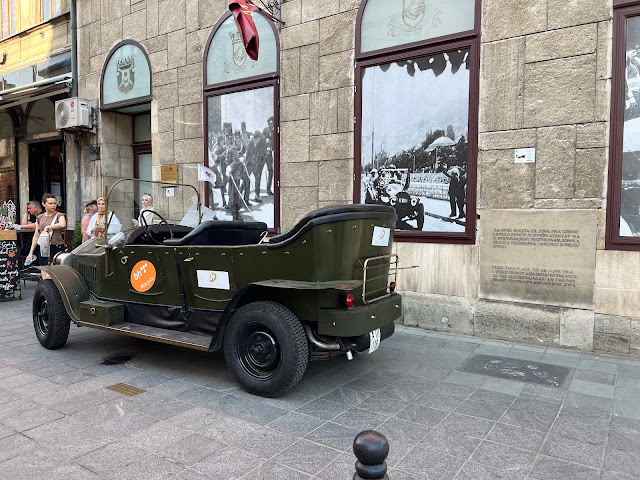






.jpeg)

.jpeg)
Comments
Post a Comment